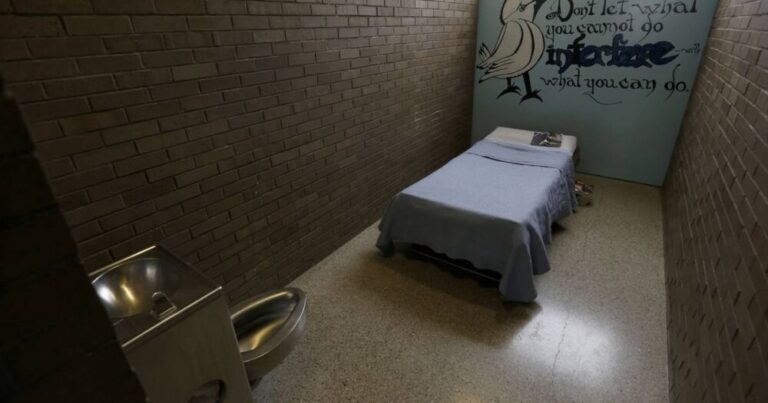Reports about the use of confinement and restraint at Cook County’s Juvenile Temporary Detention Center dominated a three-hour-long hearing this week that highlighted what advocates said was troubling treatment but offered few immediate solutions.
The JTDC is where about 180 youths aged 10 to 21 are detained at a given time while court proceedings are pending. The center is subject to varying levels of oversight from the county board, the county’s chief judge and the Administrative Office of the Illinois Courts, but recent reports from independent watchdogs have raised concerns about internal practices.
Four separate recent reports — from the University of Chicago, the state’s department of juvenile justice, the advocacy and accessibility group Equip for Equality, and the Illinois Supreme Court ― have criticized the center’s treatment of youth. Two called for either new leadership or closure of the facility entirely.
JTDC Superintendent Leonard Dixon and his staff defended center operations at the hearing Wednesday and said the reports mischaracterized internal practices. Dixon described the JTDC as a “triage” center for troubled youth accused of serious crime who were often only staying for days at a time.
A UChicago report commissioned by Chief Judge Timothy Evans found that while those held were safe while in custody, the JTDC did not “meet its affirmative duty to rehabilitate youth and help high-risk youth heal through trauma-informed, developmentally appropriate care,” in part because they are kept confined in their cells “for most of the day every day,” an approach the report’s authors described as “isolating and deprivational.”
On average, between January and July of 2021, youth were confined to their rooms 100 times per month for disciplinary reasons, that report found, and spent a median of 12 hours in the room. It also found youth were confined over 300 times per month for “non-punitive events” for a median of 16 hours at a time. Neither tally included sleeping hours.
State detention standards mandate that room confinement should not go beyond four hours without administrators or mental health staff “developing an individual plan to address the behavior.”
That panel recommended a transition to a smaller, community-based system where youth can access special programs, with a new leader “who has experience with rehabilitative programming and is committed to transforming the JTDC from simply housing youth within its charge to safely developing youth competency.”
In a separate report, Equip for Equality, a nonprofit and the federally appointed watchdog for people with disabilities in Illinois, called for the facility and the school housed in it, Nancy B. Jefferson Alternative High School, to be shut down and for youth to be transferred to community settings.
The group released its report on physical restraint and accessibility practices earlier this year after spending 1,000 hours observing the center and interviewing staff and detainees. They described feeling fear and hopelessness and reported the use of face-down and supine physical restraints and the “overuse” of rapid response staff at the JTDC that youth described as “rovers.”
The report also raised issue with the amount of time youth spent in isolation, saying that “can cause profound and lifelong psychological damage to children and adolescents” who are likely already traumatized.
Youth also told observers from the group that they were concerned that JTDC staff body cameras were “used selectively, and some areas of the facility do not have video camera coverage.”
The study further found “staff are not trained on the rights of students with disabilities and do not receive any information on the students’ disabilities, interventions, accommodations, or goals contained in their Individualized Educational Programs (IEPs) and behavior intervention plans.” Detainees are also subject to a practice residents refer to as “on the wall,” the report said, where they are made to “sit against the wall in front of their cell for sometimes as long as 15 days” during classes and not allowed to talk.
Dixon took issue with much of the report, saying it relied on “misinformation” and contained “erroneous assertions,” according to a written response to Equip for Equality obtained by Injustice Watch. Dixon wrote that it was “fundamentally impossible” for the JTDC to focus on rehabilitation, as its role is to provide short-term care for juveniles in custody.
The facility had passed state and federal reviews, he noted Wednesday. Two of the reports from the past year did commend JTDC’s medical and mental health services available, the cleanliness of the facility and programming offered for youth.
But on Wednesday, when pressed on specifics by Cook County commissioners, Dixon and other JTDC leadership did acknowledge the existence of some of the practices highlighted in the reports, but argued they maintained safety for other detainees and staff.
Commissioner Anthony Quezada asked about confinement in what are known as “holding pods,” which are separate from residential pods and which the Equip for Equality report said youth were kept in for excessive amounts of time.
“Are there, or are there not, holding pods?” Quezada asked.
Dixon replied that there are units with individual rooms that lock, but later confirmed there are designated units with holding pods, where youth involved with altercations or who “won’t participate” in classes are placed.
“It may take a couple of minutes, it may take a couple of hours,” he said, “based on the level of violence that’s going on.”
Though Dixon and other staff also denied existence of an “on the wall” policy, another member of JTDC staff described the practice as a “safe environment,” and Dixon said it was reserved for the “most violent” kids.
“It’s not called anything. It’s called an area for them to do their work, feel safe and separated so that there’s no conflicts,” JTDC caseworker Niccole Joseph-Gordon said, noting that there are often gang conflicts in the center and such separation maintains safety.
Commissioner Scott Britton also pressed Dixon on the importance of compliance with legal requirements for students with disabilities. The JTDC lacks on a memorandum of agreement with Chicago Public Schools to know which students are in need of individualized education plans. A previous agreement lapsed, which Dixon said is being worked on.
“I’m not trying to fault either group for this, but I am trying to find a way forward,” Britton said.
Dixon said: “My commitment and the commitment I have is to ensure that we give our kids the best that we can give them, because I come from the community they come from.”
Evans, who as chief judge oversees the facility, told reporters after the hearing he wants to “make certain” that “these very serious allegations” are addressed, citing the “on the wall system” and the use of face-down restraints and the goal for the center to be in compliance with the Americans with Disabilities Act before the new school year.
Evans said he was already in discussion with the Administrative Office of the Illinois Courts about new standards and that the JTDC had tweaked some of its confinement practices to ensure youth are engaged while isolated.
“I would not support (prone restraint) under any set of circumstances,” Evans said, “Now the problem is, who describes what is the prone restraint? … I’m going to have the AOIC take a look at that.”
In a Sun-Times opinion piece, the lead author of the UChicago report criticized Evans for slow-walking reforms.
Asked about the hearing Thursday, Cook County Board President Toni Preckwinkle said the county is already moving “toward a community-based approach with facilities designed to provide supportive services needed for the rehabilitation of youth, many of whom have been impacted by systemic racism, adverse childhood experiences … and trauma. Reimagining juvenile detention rehabilitation has been a longtime goal of my administration and I’m committed to helping steward this process of transformation.”







